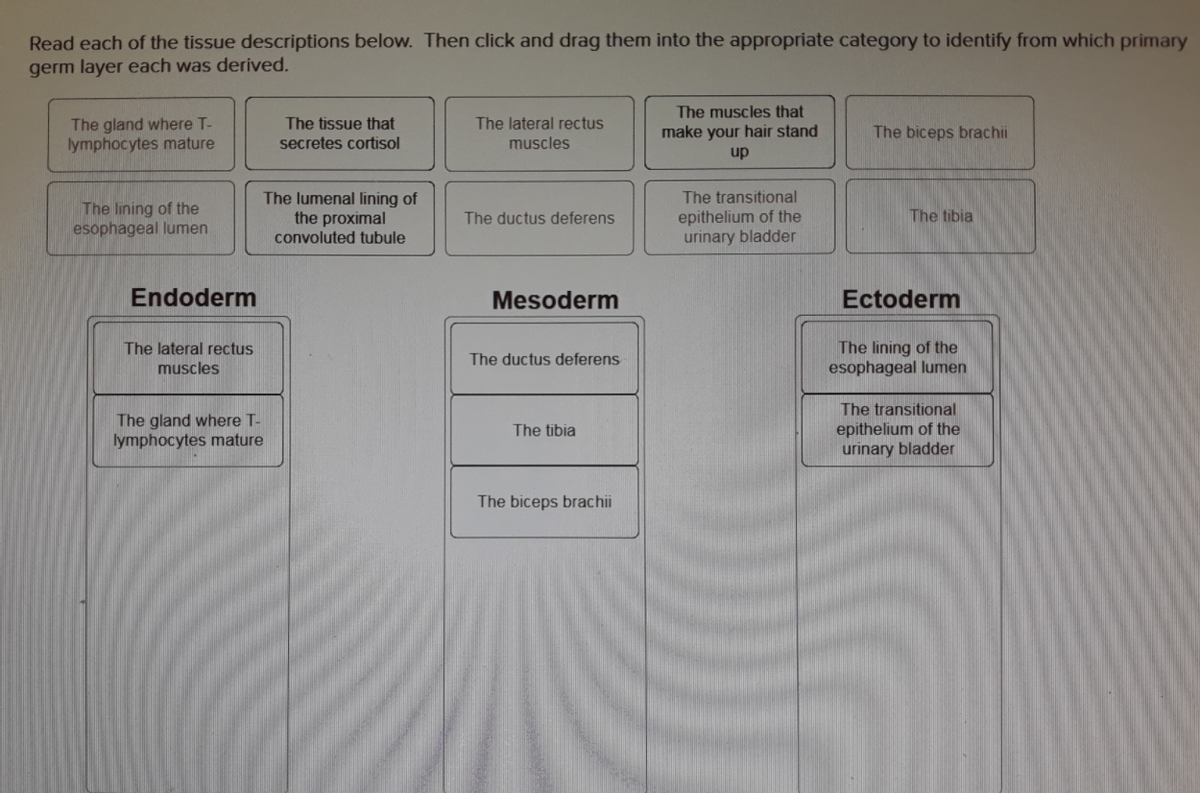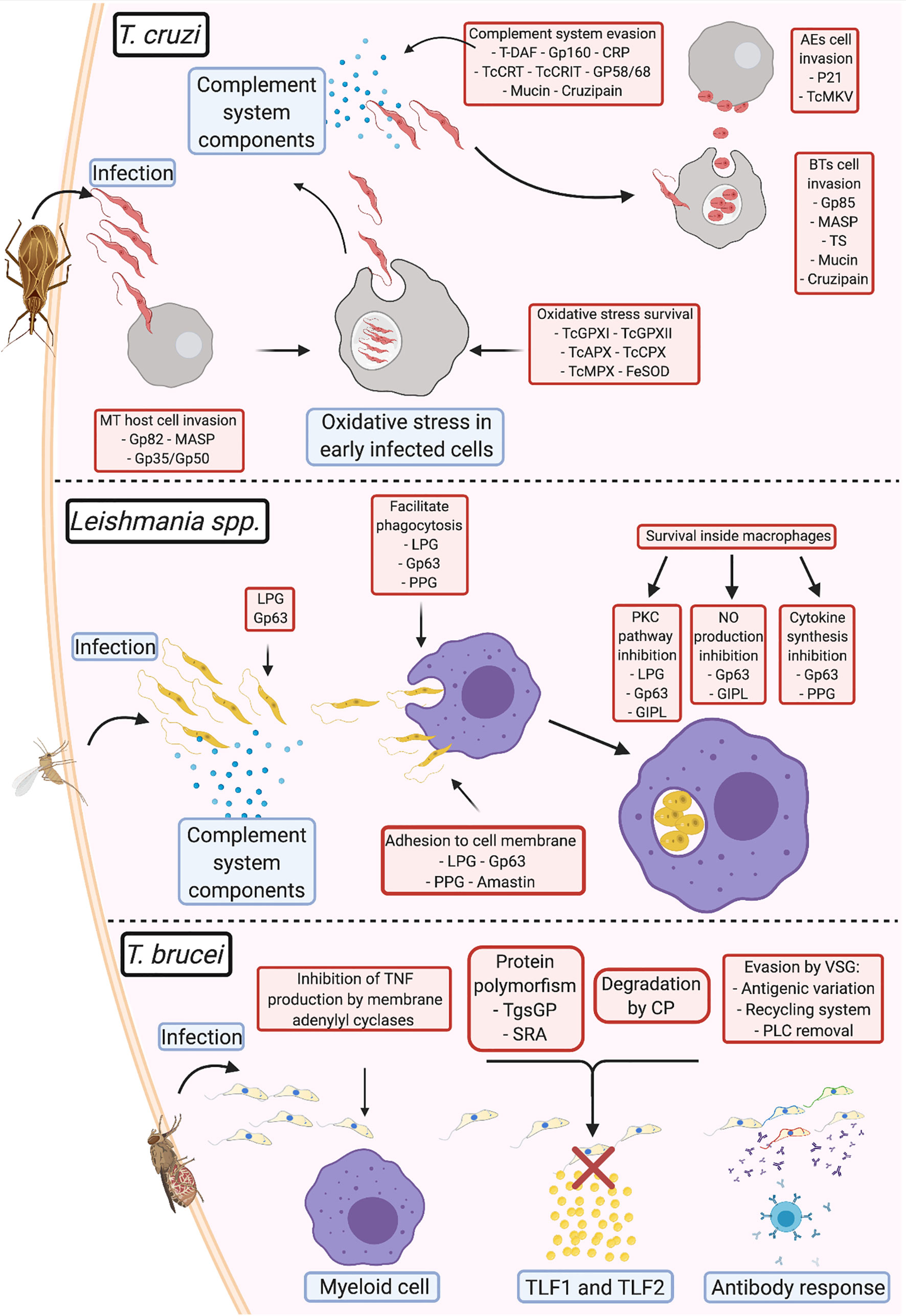42 drag each label to identify which glands would be responsible for each description
ReaderUi ReaderUi What Are Glial Cells and What Do They Do? - Verywell Health These are called glial cells. normaals/Getty Images. Originally, glial cells—also called glia or neuroglia—were believed to just provide structural support. The word glia literally means "neural glue." Relatively recent discoveries have revealed that they perform all kinds of functions in the brain and the nerves that run throughout your body.
Integumentary System | Biology for Majors II - Lumen Learning Identify the structure and function of the integumentary system. The integumentary system consists of the skin, hair, nails, the subcutaneous tissue below the skin, and assorted glands.The most obvious function of the integumentary system is the protection that the skin gives to underlying tissues. The skin not only keeps most harmful ...
Drag each label to identify which glands would be responsible for each description
Tissues - Epithelium, Muscle, Connective Tissue and Nervous Tissue ... Secretes - forms glands; Characteristics (Traits): 1) Closely attached to each other forming a protective barrier. 2) Always has one free (apical) surface open to outside the body or inside (cavity) an internal organ. 3) Always had one fixed (basal) section attached to underlying connective tissue. Nervous Tissue - Characteristics, Structure, Function - BYJUS Dendrite is a highly branched processes, responsible for receiving information from other neurons and synapses (specialized point of contact). Information of other neurons is provided by dendrites to connect with its cell body. Information in a neuron is unidirectional as it passes through neurons from dendrites, across the cell body down the axon. Solved amework Drag each label to identify which glands - Chegg Question: amework Drag each label to identify which glands would be responsible for each description Steroid Dopamine Thyroid hormone Norepinerne Adrenocorticotropic hormone Ewe Own Glucagon < Prev 1 of 50 Next > N This problem has been solved! See the answer Show transcribed image text Expert Answer 88% (17 ratings)
Drag each label to identify which glands would be responsible for each description. Diagram of the Digestive System And an Explanation of its ... - Bodytomy Here are some facts about the digestive system: • We produce almost one quart of saliva every day. • Saliva is 98% water and only 2% enzymes. • Length of the digestive tract is about 30 feet. • Food stays in the stomach for almost 2 to 3 hours. • The small intestine is almost 20 feet long. Accessory Glands | SEER Training Accessory Glands. The accessory glands of the male reproductive system are the seminal vesicles, prostate gland, and the bulbourethral glands.These glands secrete fluids that enter the urethra.. Seminal Vesicles. The paired seminal vesicles are saccular glands posterior to the urinary bladder.Each gland has a short duct that joins with the ductus deferens at the ampulla to form an ejaculatory ... Layers of the Skin | Anatomy and Physiology I - Lumen Learning The first is a Merkel cell, which functions as a receptor and is responsible for stimulating sensory nerves that the brain perceives as touch. These cells are especially abundant on the surfaces of the hands and feet. The second is a melanocyte, a cell that produces the pigment melanin. Layers of the Skin | Anatomy and Physiology | | Course Hero The first is a Merkel cell, which functions as a receptor and is responsible for stimulating sensory nerves that the brain perceives as touch. These cells are especially abundant on the surfaces of the hands and feet. The second is a melanocyte, a cell that produces the pigment melanin.
What is Endocrine System? - BYJUS Thyroid gland The thyroid glands can be found at the front of the neck. It sits low in the throat, between the windpipe. Brownish red, it has blood vessels coursing through it. It secretes hormones that are collectively called thyroid hormones. The most prominent are T3 and T4, which influence the body's rate of metabolism. Parathyroid glands The Adrenal Glands | Anatomy and Physiology II | | Course Hero The adrenal glands, located superior to each kidney, consist of two regions: the adrenal cortex and adrenal medulla. The adrenal cortex—the outer layer of the gland—produces mineralocorticoids, glucocorticoids, and androgens. The adrenal medulla at the core of the gland produces epinephrine and norepinephrine. Sign In - Ivy Tech Community College of Indiana Reset or Forgot Password Need help? Call 1-888-IVY-LINE (option 4). Types of Tissues - Anatomy & Physiology The Four Types of Tissues. Epithelial tissue, also referred to as epithelium, refers to the sheets of cells that cover exterior surfaces of the body, lines internal cavities and passageways, and forms certain glands. Connective tissue, as its name implies, binds the cells and organs of the body together and functions in the protection, support, and integration of all parts of the body.
Solved Drag each label to identify which glands would be - Chegg Drag each label to identify which glands would be responsible for each descriptive role or function. Each gland may have more than one match, so be sure to place all descriptions. Thymus and/or Thyroid Pancreas and/or Adrenals Gonads Glands that produce hormones of sympathetically dominant states = Includes the principal glands of metabolic control Drag each label to identify which glands would be responsible for each ... Endocrine glands are part of our endocrine system that is responsible for making hormones and release them into our bloodstream. These hormones control a number of important functions in your body, such as growth and development. So we can conclude that endocrine glands are responsible for the descriptive function in our body. Glands - The Endocrine System Chart - ThoughtCo The major glands of the endocrine system are the pineal gland, pituitary gland, thyroid, and parathyroid glands, adrenal glands, pancreas, thymus, ovaries, and testes. There are also other organs in the body that have secondary endocrine functions. These organs include the heart, liver, and kidneys . Pineal Gland Drag each tile to the correct location on the image. The tiles are used ... Drag each tile to the correct location on the image. The tiles are used more than once. ... Label each excerpt with the literary period it belongs to. romanticism realism 2 See answers Advertisement Advertisement annyksl annyksl Answer: ... Responsible Disclosure Agreement Get the Brainly App Download iOS App
A Labeled Diagram of the Plant Cell and Functions of its Organelles The centrosome is located close to the nucleus and is a small body made up of radiating tubules. It is responsible for producing and organizing the microtubules. In plant cells, the centrosome is a 'centriole-free' organelle. It is also called the Microtubule-organizing center (MTOC). Function: Regulates cell-cycle progression.
Endocrine System Organs, Glands | Hormones and Metabolism The pancreas is a gland of both the digestive and endocrine systems. As an endocrine gland, it produces several important hormones, including insulin, glucagon, somatostatin, and pancreatic polypeptide. It secretes pancreatic enzymes that facilitate digestion, and the absorption of nutrients in the small intestine.
PDF Practice Quiz Tissues - Portland Community College •Largest ducts of sweat, mammary and salivary glands Identify the tissue type and a location where it is found. Ciliated Pseudostratified Columnar Epithelium •Trachea and most of the upper respiratory tract Identify the tissue type and a location where it is found. Adipose Tissue •Under skin •Around kidneys •Breasts •Yellow bone marrow
Endocrine Glands and Functions - Bodytomy The function of this endocrine gland is to secrete melatonin. It is at the base of the brain, and is responsible for alertness or consciousness of one's self. Gonads Male gonads are known as the testes, and ovaries in case of females. These glands produce hormones and cells that are vital to reproduction, in males and females.
BIO Ch 17 endocrine system from HW Flashcards - Quizlet Each label contains a hormone and resulting internal body condition. Drag each label to identify whether the condition would be caused by hyposecretion or hypersecretion of the given hormone. pic The __________ is not an endocrine gland but it has a role in endocrine function. kidney Which of the following is not a role of prostaglandins?
PDF OpenALG OpenALG
Anatomy & Physiology: The Unity of Form and Function - Quizlet Drag each label to identify which glands would be responsible for each description: MONOAMINE • Dopamine • Norepinephrine • Thyroid Hormone. ... Drag each label to identify which glands would be responsible for each descriptive role or function: PANCREAS and/or ADRENALS
Solved amework Drag each label to identify which glands - Chegg Question: amework Drag each label to identify which glands would be responsible for each description Steroid Dopamine Thyroid hormone Norepinerne Adrenocorticotropic hormone Ewe Own Glucagon < Prev 1 of 50 Next > N This problem has been solved! See the answer Show transcribed image text Expert Answer 88% (17 ratings)
Nervous Tissue - Characteristics, Structure, Function - BYJUS Dendrite is a highly branched processes, responsible for receiving information from other neurons and synapses (specialized point of contact). Information of other neurons is provided by dendrites to connect with its cell body. Information in a neuron is unidirectional as it passes through neurons from dendrites, across the cell body down the axon.
Tissues - Epithelium, Muscle, Connective Tissue and Nervous Tissue ... Secretes - forms glands; Characteristics (Traits): 1) Closely attached to each other forming a protective barrier. 2) Always has one free (apical) surface open to outside the body or inside (cavity) an internal organ. 3) Always had one fixed (basal) section attached to underlying connective tissue.





























Post a Comment for "42 drag each label to identify which glands would be responsible for each description"